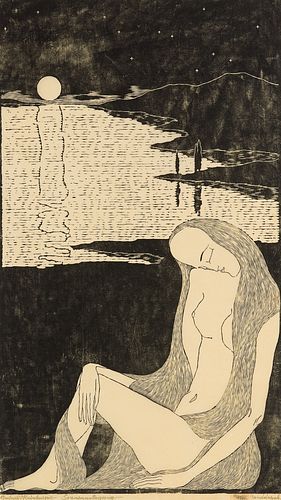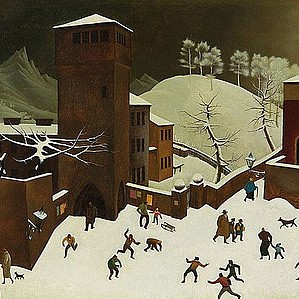GERTRAUD REINBERGER- BRAUSEWETTER (Vienna 1903 . 1992) Sunset, 1925
Lot 45
Categories
Estimate:
EUR€800 - EUR€1,500
$860.22 - $1,612.90
Absentee vs Live bid
Two ways to bid:
- Leave a max absentee bid and the platform will bid on your behalf up to your maximum bid during the live auction.
- Bid live during the auction and your bids will be submitted real-time to the auctioneer.
Bid Increments
| Price | Bid Increment |
|---|---|
| EUR€0 | EUR€10 |
| EUR€100 | EUR€50 |
| EUR€700 | EUR€100 |
| EUR€1,000 | EUR€200 |
| EUR€3,000 | EUR€300 |
| EUR€3,600 | EUR€400 |
| EUR€4,000 | EUR€500 |
| EUR€7,000 | EUR€1,000 |
| EUR€16,000 | EUR€2,000 |
| EUR€30,000 | EUR€3,000 |
| EUR€36,000 | EUR€4,000 |
| EUR€40,000 | EUR€5,000 |
About Auction
By Widder Auctions
May 19, 2022
Set Reminder
2022-05-19 11:00:00
2022-05-19 11:00:00
America/New_York
Bidsquare
Bidsquare : Masterpieces
https://www.bidsquare.com/auctions/widder-auctions/masterpieces-9287
Masterpieces of classical modernism by Austrian and international artists coming up for auction in Vienna on May 19th Widder Auctions office@widderauktionen.com
Masterpieces of classical modernism by Austrian and international artists coming up for auction in Vienna on May 19th Widder Auctions office@widderauktionen.com
- Lot Description
GERTRAUD REINBERGER- BRAUSEWETTER*
(Vienna 1903 . 1992)
Sunset, 1925
woodcut/paper, 79 x 44,5 cm
signed Gertraud Reinberger, dated 1925 and inscribed Sonnenuntergang Handdruck
Provenance: private property Vienna
ESTIMATE °€ 800 - 1.500
Austrian artist of the 20th century. Studied at the School of Arts and Crafts in the youth art class of Franz Cizek, there contact with Kinetism. Occupied with theosophy, antroposophy and religious themes. From 1915 for several years associated with the writer Gustav Meyrink. In 1931 the Albertina purchased 58 woodcuts, a year later participation in the exhibition Christian Art in the Secession in Vienna. After Cizek's death, 1946 to 1948, head of the youth art class. Stylistic development between fin de siècle, Art Nouveau and Art Deco, interest in ornament, line, rhythm, light and shadow. Female nudes, women, themes around love, life, death, closeness, tenderness, symbolic and iconic representations. Created mainly woodcuts, figural representations comparable to Carry Hauser.
The Viennese graphic artist and woodcut artist Gertraud Reinberger-Brausewetter is one of Franz ?ižek's lesser-known students at the Vienna School of Applied Arts. She was born as the second eldest of four siblings in the master builder family Brausewetter, founders of the still existing company Pittel & Brausewetter, and at the age of 14 she was already in the youth class of ?ižek, which she was to direct after his death from 1946 to 1948. The first major artistic commission for the eleven-year-old was the Annunciation scene, which was still entirely committed to Art Nouveau and was executed in tempera technique in 1914 in the porch of the Church of St. Othmar in Mödling, which her father had built in 1904. In 1916 she made her first woodcuts. After the end of the First World War she returned to ?ižek at the School of Applied Arts, where she studied in the modern art department until 1921 and subsequently dealt with theosophical and anthroposophical themes. These woodcuts also date to the 1920s, some of which are still rooted in the ornamental practice of Secession art and Art Deco. The present picture shows a sleeping female figure with closed eyes and bowed head. Night, sleep and dreams are discussed as different reality and mirrors of human consciousness. According to anthroposophical understanding, the "dream consciousness" is a transformed rudiment of the "image consciousness" that man had on the "old moon". The dream is associated with vivid images and intense feelings, the ego-consciousness in the dream is only vaguely present, since the dream does not sufficiently differentiate between inside and outside: "We swim together with our dream world and cannot really distinguish ourselves from it." The surreal moment is particularly expressed in "Sunset" through the hair, in which the otherwise naked woman is partially wrapped and which must have reminded the artist, inspired by Christian imagery, of the depictions of Mary Magdalene, which go back to the Legenda Aurea. A mystical power seems to emanate from the setting sun, which is reflected in the lake and illuminates the scene. The fact that the stars are already in the sky takes the scene further away from the sphere of waking everyday reality.
PLEASE NOTE:
The purchase price consists of the highest bid plus the buyer's premium, sales tax and, if applicable, the fee of artists resale rights. In the case of normal taxation (marked ° in the catalog), a premium of 24% is added to the highest bid. The mandatory sales tax of 13% is added to the sum of the highest bid and the buyer's premium. The buyer's premium amounts to 28% in case of differential taxation. The sales tax is included in the differential taxation. - Shipping Info
-
Shipping
We will send you the invoice shortly after the auction. As soon as we have recieved the amount, the art can be picked up at Johannesgasse 9-13, 1010 Vienna. Please note that the buyer is responsible for pick-up and shipping of the lot.
Should you wish to ship your items, please contact: Mailboxes Email: oper@mbe-co.at Tel: 01 5128855
Please note that storage fees may apply, should the pieces not be picked up within 14 days after invoicing for domestic and 28 days for international transportation.
Our team will be happy to assist you with any further information at office@widderauktionen.com or at 0043 676 555 66 10.
-
- Buyer's Premium



 EUR
EUR CAD
CAD AUD
AUD GBP
GBP MXN
MXN HKD
HKD CNY
CNY MYR
MYR SEK
SEK SGD
SGD CHF
CHF THB
THB













